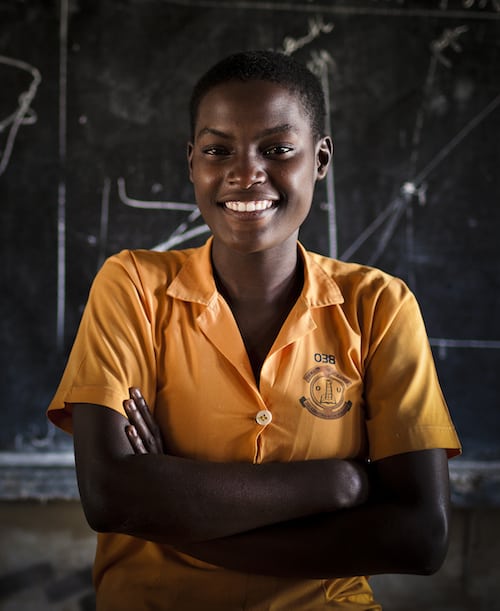The Secondary School Abyss: Can Public Private Partnerships Help?
The first thing I’m asked when I tell someone that I run a network of secondary schools is invariably, “Why secondary education?” The answer is that the children of girls who complete secondary school (11th grade) are half as likely to die in infancy as those of girls who drop out after primary. Yes, really. That fact alone is enough to make me jump out of bed every morning. (Except for today when I’m lying in bed writing a blog for NextBillion.)
One of the Millennium Development Goals was a push for universal primary education. This produced a wave of primary school finishers who are now at the top of an education cliff, peering into the abyss. There are simply too few secondary schools to absorb these students. In Uganda, for example, just one in four students accesses secondary school. With a population growing at over 3 percent a year, the government is chasing a target which sometimes feels like it’s receding into the distance.
Something needs to be done, and fast. However, that “something” needs to be “the right something.” Just because things are currently bad isn’t an excuse to try just anything. Yes, it’s true that existing systems are failing to meet the scale of the problem – there aren’t enough schools and those that do exist often provide poor-quality education. But this doesn’t mean that we should prioritise short-term “quick wins” over responsible, long-term, sustainable solutions.
Pioneering PEAS
 At PEAS, the organisation I founded, we’re concentrating on “the right something.” That was initially quite simple: building and running not-for-profit secondary schools in areas of Uganda and Zambia where demand outstrips supply. A few years ago that approach was supplemented by entering public private partnerships (PPPs) with local education ministries. Under each PPP, the governments provide PEAS schools with a per-pupil grant. This contribution allows us to run great schools which are financially sustainable at an ever-decreasing cost to the student. Ten years on, PEAS is partnering with both governments to educate 16,000 students across 28 schools in Uganda and two in Zambia. We aim to grow enrollment to 60,000 over the coming years.
At PEAS, the organisation I founded, we’re concentrating on “the right something.” That was initially quite simple: building and running not-for-profit secondary schools in areas of Uganda and Zambia where demand outstrips supply. A few years ago that approach was supplemented by entering public private partnerships (PPPs) with local education ministries. Under each PPP, the governments provide PEAS schools with a per-pupil grant. This contribution allows us to run great schools which are financially sustainable at an ever-decreasing cost to the student. Ten years on, PEAS is partnering with both governments to educate 16,000 students across 28 schools in Uganda and two in Zambia. We aim to grow enrollment to 60,000 over the coming years.
PEAS’ efforts are helping solve the “education cliff” problem but with 55 million children out of school in sub-Saharan Africa, PEAS can’t (and doesn’t want to) run every school that’s needed. To get every child into secondary school, PEAS would have to grow a thousand-fold. Or, stated another way, 1,000 organisations like PEAS could fill the gap.
With that in mind, PEAS has now embarked on a new journey. We want to work alongside an informal coalition of partners, including governments, to create a PPP school movement across sub-Saharan Africa. This movement would stimulate the development of more school networks like PEAS to partner with governments to fill the gap.
Such a plan is not without controversy. And, as the founder of a school network, I see it as my responsibility to continually question whether we are doing “the right something” for the whole system and not just for PEAS. Badly designed or badly implemented PPPs can risk entrenching educational inequality. So the work we now undertake isn’t simply to lobby for PPPs but to collaborate with governments to explore PPPs as a potential long-term solution – to consider the potential benefits, the many pitfalls and the necessary policy and regulatory frameworks.
The principles of partnership
So what makes a good school management PPP? The answer, as usual, depends on context. In particular it depends on the government’s capacity to contract private partners and to hold them to account. The government has to be sure that it will be better at contracting and regulating schools than it is at running schools itself.
Having said that, PEAS holds a few principles for an effective PPP: (1) maximise the autonomy of school operators to make decisions around inputs; (2) concentrate accountability on learning outcomes; (3) regulate admissions to protect access and equity; (4) invest in a school inspectorate to ensure schools can’t simply “game” learning outcomes (by kicking out academically weaker kids/teaching to the test); (5) focus the PPP on a particular problem, like improving the 200 weakest schools or creating new schools in tough areas.
It remains to be seen whether there are enough high-quality school operators to partner with governments to address the access and quality gaps at the secondary education level. My hunch is that if the PPP policy is right, they will emerge. In any case, done well, a PPP can drive reforms in school regulation and accountability which also benefit state-run schools. After all, those state schools also often lack autonomy and accountability. A better school inspectorate will lead to improvements in all schools, not just PPP schools.
Apart from the PPPs PEAS is involved in in Zambia and Uganda, a number of other pilot PPP approaches in developing countries have sprung up in the past few years. The most well-known is Partnership Schools for Liberia, but there’s also a “collaboration schools” PPP in the Western Cape, South Africa and government partnership schools in Delhi. More PPP programmes will inevitably follow. This trickle of PPP pilots in the developing world certainly feels like the first stages of the PPP school movement.
Millions of kids aren’t getting to secondary school and millions more aren’t learning much when they get there. Yet, with 60 percent of PEAS students coming from the poorest two fifths of Uganda families and learning faster than students in other schools, it makes sense for governments across Africa to partner with PEAS-type networks, especially where those networks are focused on equity, access and quality of education.
Remember, just 1,000 PEAS-type networks working in partnership with governments are needed to educate every out-of-school child. So the momentum behind well-designed PPPs is timely. If done well, they might just be “the right something” – and that’s why it’s about time I got out of bed.
John Rendel is the founder and CEO of PEAS, a social enterprise that widens access to secondary education in Africa.
Photos courtesy of PEAS
- Categories
- Education



